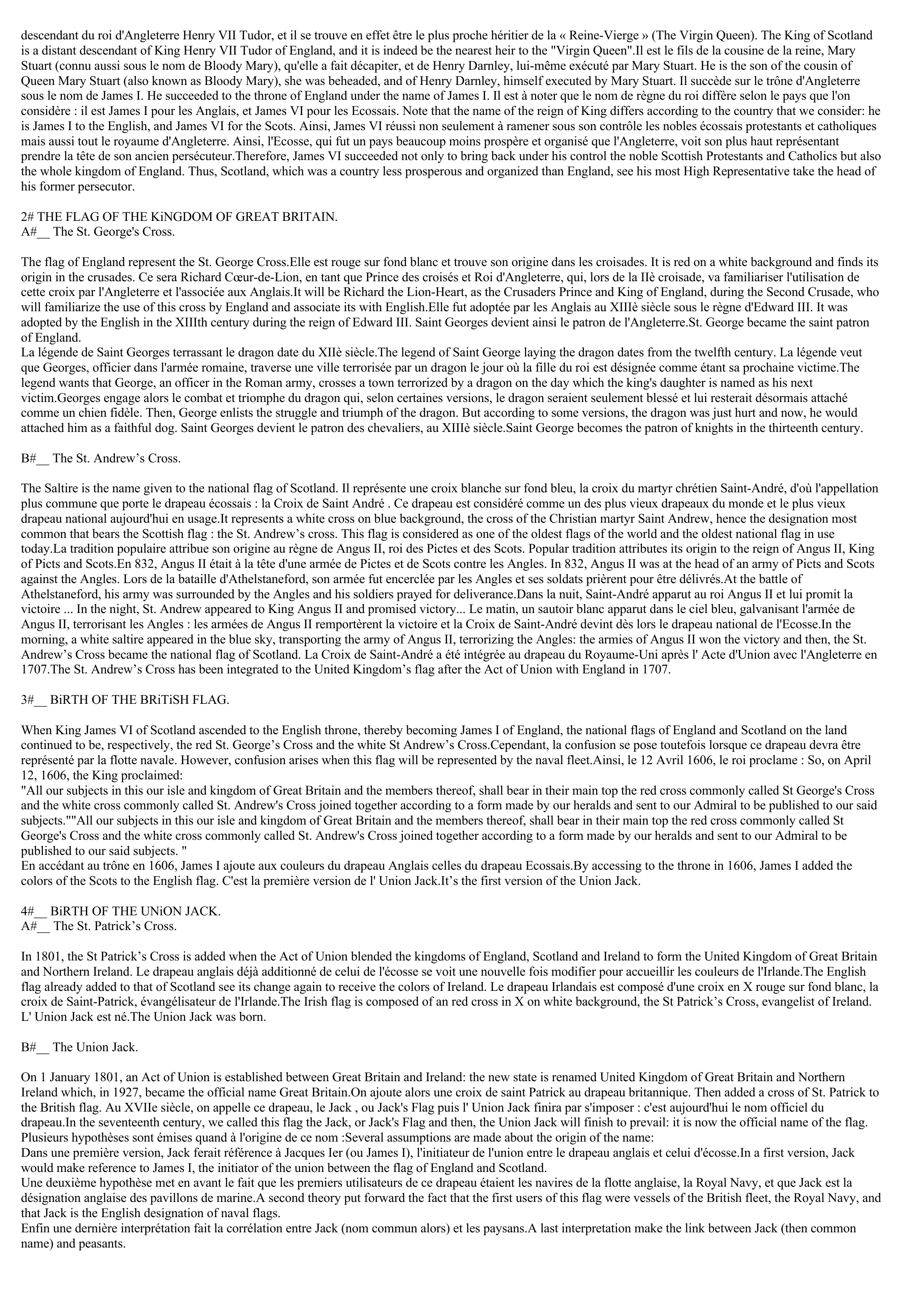HiSTOiRE DE UNiON JACK
Publié le 05/09/2012
Extrait du document

Quand le roi James VI d’Ecosse monta sur le trône d’Angleterre, devenant ainsi James I d’Angleterre, les drapeaux nationaux d’Angleterre et d’Ecosse sur les terres continuent d’être, respectivement, la croix rouge de Saint Georges et la croix blanche de Saint Andrew. Cependant, la confusion se pose toutefois lorsque ce drapeau devra être représenté par la flotte navale. Ainsi, le 12 Avril 1606, le roi proclame : "All our subjects in this our isle and kingdom of Great Britain and the members thereof, shall bear in their main top the red cross commonly called St George's Cross and the white cross commonly called St. Andrew's Cross joined together according to a form made by our heralds and sent to our Admiral to be published to our said subjects." En accédant au trône en 1606, James I ajoute aux couleurs du drapeau Anglais celles du drapeau Ecossais. C’est la première version de l’Union Jack.

«
descendant du roi d'Angleterre Henry VII Tudor, et il se trouve en effet être le plus proche héritier de la « Reine-Vierge » (The Virgin Queen).
The King of Scotlandis a distant descendant of King Henry VII Tudor of England, and it is indeed be the nearest heir to the "Virgin Queen".Il est le fils de la cousine de la reine, MaryStuart (connu aussi sous le nom de Bloody Mary), qu'elle a fait décapiter, et de Henry Darnley, lui-même exécuté par Mary Stuart.
He is the son of the cousin ofQueen Mary Stuart (also known as Bloody Mary), she was beheaded, and of Henry Darnley, himself executed by Mary Stuart.
Il succède sur le trône d'Angleterresous le nom de James I.
He succeeded to the throne of England under the name of James I.
Il est à noter que le nom de règne du roi diffère selon le pays que l'onconsidère : il est James I pour les Anglais, et James VI pour les Ecossais.
Note that the name of the reign of King differs according to the country that we consider: heis James I to the English, and James VI for the Scots.
Ainsi, James VI réussi non seulement à ramener sous son contrôle les nobles écossais protestants et catholiquesmais aussi tout le royaume d'Angleterre.
Ainsi, l'Ecosse, qui fut un pays beaucoup moins prospère et organisé que l'Angleterre, voit son plus haut représentantprendre la tête de son ancien persécuteur.Therefore, James VI succeeded not only to bring back under his control the noble Scottish Protestants and Catholics but alsothe whole kingdom of England.
Thus, Scotland, which was a country less prosperous and organized than England, see his most High Representative take the head ofhis former persecutor.
2# THE FLAG OF THE KiNGDOM OF GREAT BRITAIN.A#__ The St.
George's Cross.
The flag of England represent the St.
George Cross.Elle est rouge sur fond blanc et trouve son origine dans les croisades.
It is red on a white background and finds itsorigin in the crusades.
Ce sera Richard Cœur-de-Lion, en tant que Prince des croisés et Roi d'Angleterre, qui, lors de la IIè croisade, va familiariser l'utilisation decette croix par l'Angleterre et l'associée aux Anglais.It will be Richard the Lion-Heart, as the Crusaders Prince and King of England, during the Second Crusade, whowill familiarize the use of this cross by England and associate its with English.Elle fut adoptée par les Anglais au XIIIè siècle sous le règne d'Edward III.
It wasadopted by the English in the XIIIth century during the reign of Edward III.
Saint Georges devient ainsi le patron de l'Angleterre.St.
George became the saint patronof England.La légende de Saint Georges terrassant le dragon date du XIIè siècle.The legend of Saint George laying the dragon dates from the twelfth century.
La légende veutque Georges, officier dans l'armée romaine, traverse une ville terrorisée par un dragon le jour où la fille du roi est désignée comme étant sa prochaine victime.Thelegend wants that George, an officer in the Roman army, crosses a town terrorized by a dragon on the day which the king's daughter is named as his nextvictim.Georges engage alors le combat et triomphe du dragon qui, selon certaines versions, le dragon seraient seulement blessé et lui resterait désormais attachécomme un chien fidèle.
Then, George enlists the struggle and triumph of the dragon.
But according to some versions, the dragon was just hurt and now, he wouldattached him as a faithful dog.
Saint Georges devient le patron des chevaliers, au XIIIè siècle.Saint George becomes the patron of knights in the thirteenth century.
B#__ The St.
Andrew’s Cross.
The Saltire is the name given to the national flag of Scotland.
Il représente une croix blanche sur fond bleu, la croix du martyr chrétien Saint-André, d'où l'appellationplus commune que porte le drapeau écossais : la Croix de Saint André .
Ce drapeau est considéré comme un des plus vieux drapeaux du monde et le plus vieuxdrapeau national aujourd'hui en usage.It represents a white cross on blue background, the cross of the Christian martyr Saint Andrew, hence the designation mostcommon that bears the Scottish flag : the St.
Andrew’s cross.
This flag is considered as one of the oldest flags of the world and the oldest national flag in usetoday.La tradition populaire attribue son origine au règne de Angus II, roi des Pictes et des Scots.
Popular tradition attributes its origin to the reign of Angus II, Kingof Picts and Scots.En 832, Angus II était à la tête d'une armée de Pictes et de Scots contre les Angles.
In 832, Angus II was at the head of an army of Picts and Scotsagainst the Angles.
Lors de la bataille d'Athelstaneford, son armée fut encerclée par les Angles et ses soldats prièrent pour être délivrés.At the battle ofAthelstaneford, his army was surrounded by the Angles and his soldiers prayed for deliverance.Dans la nuit, Saint-André apparut au roi Angus II et lui promit lavictoire ...
In the night, St.
Andrew appeared to King Angus II and promised victory...
Le matin, un sautoir blanc apparut dans le ciel bleu, galvanisant l'armée deAngus II, terrorisant les Angles : les armées de Angus II remportèrent la victoire et la Croix de Saint-André devint dès lors le drapeau national de l'Ecosse.In themorning, a white saltire appeared in the blue sky, transporting the army of Angus II, terrorizing the Angles: the armies of Angus II won the victory and then, the St.Andrew’s Cross became the national flag of Scotland.
La Croix de Saint-André a été intégrée au drapeau du Royaume-Uni après l' Acte d'Union avec l'Angleterre en1707.The St.
Andrew’s Cross has been integrated to the United Kingdom’s flag after the Act of Union with England in 1707.
3#__ BiRTH OF THE BRiTiSH FLAG.
When King James VI of Scotland ascended to the English throne, thereby becoming James I of England, the national flags of England and Scotland on the landcontinued to be, respectively, the red St.
George’s Cross and the white St Andrew’s Cross.Cependant, la confusion se pose toutefois lorsque ce drapeau devra êtrereprésenté par la flotte navale.
However, confusion arises when this flag will be represented by the naval fleet.Ainsi, le 12 Avril 1606, le roi proclame : So, on April12, 1606, the King proclaimed:"All our subjects in this our isle and kingdom of Great Britain and the members thereof, shall bear in their main top the red cross commonly called St George's Crossand the white cross commonly called St.
Andrew's Cross joined together according to a form made by our heralds and sent to our Admiral to be published to our saidsubjects.""All our subjects in this our isle and kingdom of Great Britain and the members thereof, shall bear in their main top the red cross commonly called StGeorge's Cross and the white cross commonly called St.
Andrew's Cross joined together according to a form made by our heralds and sent to our Admiral to bepublished to our said subjects.
"En accédant au trône en 1606, James I ajoute aux couleurs du drapeau Anglais celles du drapeau Ecossais.By accessing to the throne in 1606, James I added thecolors of the Scots to the English flag.
C'est la première version de l' Union Jack.It’s the first version of the Union Jack.
4#__ BiRTH OF THE UNiON JACK.A#__ The St.
Patrick’s Cross.
In 1801, the St Patrick’s Cross is added when the Act of Union blended the kingdoms of England, Scotland and Ireland to form the United Kingdom of Great Britainand Northern Ireland.
Le drapeau anglais déjà additionné de celui de l'écosse se voit une nouvelle fois modifier pour accueillir les couleurs de l'Irlande.The Englishflag already added to that of Scotland see its change again to receive the colors of Ireland.
Le drapeau Irlandais est composé d'une croix en X rouge sur fond blanc, lacroix de Saint-Patrick, évangélisateur de l'Irlande.The Irish flag is composed of an red cross in X on white background, the St Patrick’s Cross, evangelist of Ireland.L' Union Jack est né.The Union Jack was born.
B#__ The Union Jack.
On 1 January 1801, an Act of Union is established between Great Britain and Ireland: the new state is renamed United Kingdom of Great Britain and NorthernIreland which, in 1927, became the official name Great Britain.On ajoute alors une croix de saint Patrick au drapeau britannique.
Then added a cross of St.
Patrick tothe British flag.
Au XVIIe siècle, on appelle ce drapeau, le Jack , ou Jack's Flag puis l' Union Jack finira par s'imposer : c'est aujourd'hui le nom officiel dudrapeau.In the seventeenth century, we called this flag the Jack, or Jack's Flag and then, the Union Jack will finish to prevail: it is now the official name of the flag.Plusieurs hypothèses sont émises quand à l'origine de ce nom :Several assumptions are made about the origin of the name:Dans une première version, Jack ferait référence à Jacques Ier (ou James I), l'initiateur de l'union entre le drapeau anglais et celui d'écosse.In a first version, Jackwould make reference to James I, the initiator of the union between the flag of England and Scotland.Une deuxième hypothèse met en avant le fait que les premiers utilisateurs de ce drapeau étaient les navires de la flotte anglaise, la Royal Navy, et que Jack est ladésignation anglaise des pavillons de marine.A second theory put forward the fact that the first users of this flag were vessels of the British fleet, the Royal Navy, andthat Jack is the English designation of naval flags.Enfin une dernière interprétation fait la corrélation entre Jack (nom commun alors) et les paysans.A last interpretation make the link between Jack (then commonname) and peasants..
»
↓↓↓ APERÇU DU DOCUMENT ↓↓↓
Liens utiles
- doña Christina au désespoir ; acide prussique ; pompe stomacale dans mon portemanteau ; je pratique l'opération ; vieux Bolaro en extase, consent à notre union ; joint nos mains, ruisseaux de pleurs ; histoire romantique, très-romantique.
- Histoire de l’Union Européenne
- Afrique du sud (UNION SUD-AFRICAINE) de 1910 à 1919 : Histoire
- Union soviétique de 1920 à 1929 : Histoire
- Union soviétique de 1930 à 1939 : Histoire

































